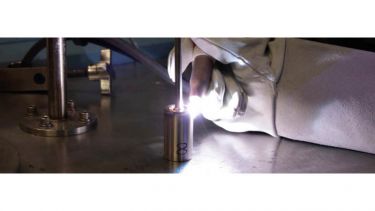Contributing Towards Nuclear Waste Management
Radiological Hot Isostatic Pressing at The University of Sheffield: A case study by the NucleUS Immobilisation Science Laboratory into the Management of the UK Plutonium Inventory.
Our nuclear research Hot Isostatic Press - HIP - [AIP6-30H] is fundamental to underpinning suitable products [waste forms] as an option for immobilising a wide range of radioactive wastes arising from civil nuclear energy programmes in the UK, Europe, and Japan.
The advantages of thermally treating radioactive wastes via hot isostatic pressing include: waste consolidation, high waste loadings, minimal secondary wastes, and it is a batch process allowing inventory accountancy and independent of scale.
HIP'ing in the field of radioactive waste management has largely focused on simulate materials owing to the hazards associated with handling radioactive materials and lack of available nuclearised processing equipment. However, to verify that these surrogate engineered waste forms are suitable for implementation by the nuclear industry, it is crucial to demonstrate that their defining characteristics translate to real radioactive wastes when processed.
The nuclear research HIP at The University of Sheffield has two novel Active Furnace Isolation Chambers (AFIC) that are self-contained plug-in components, shown below. It provides our team with the unique functionality to hot isostatically press materials containing uranium and thorium in a controlled environment with up to 50g of UO2 / ThO2 in a single product.
Our team are using the unique capability to build close relationships with key nuclear stakeholders, end-users, and other researchers, to develop ceramic and glass-ceramic based waste forms, ranging from radioactively-contaminated spent ion exchange materials, sludges, and ashes to simulate nuclear fuels (SIMfuels), high actinide wastes, and options for the disposition of the UK's inventory of separated civil plutonium.
Our small-scale HIP facility provides opportunities for (and verification of) systematic refinement of targeted waste form characteristics, based on stakeholder requirements, prior to demonstrations with real wastes, which will be ultimately limited in scope prior to the full-scale deployment. The research and development undertaken using the nuclear research HIP allows confidence to be gained in the HIP process and the final waste forms via a wide ranging safety assessment (e.g. radiation tolerance, disposability, waste compatibility).
To cement our position, we are providing knowledge transfer of radioactive HIP'ing to key industrial partners, including discussions on mis-operations, component fatigue, user handling, and sample preparation requirements.
In our commitment to drive this research forward, the nuclear research HIP was recently upgraded with successful funding from the EPSRC National Nuclear User Facility fund, which established the HADES [High Activity Decommissioning Engineering and Science] facility, ensuring we can provide a nuclear HIP facility for the next 10 years (and more!) to continue our mission of supporting nuclear waste management at the national level and worldwide.
CASE STUDY OF RESEARCH ENABLED BY THE RADIOLOGICAL HIP FACILITY:
MANAGEMENT OF THE UK PLUTONIUM INVENTORY
The UK manages an inventory of around 140 tonnes of civil separated plutonium as a result of spent nuclear fuel reprocessing. One option currently being explored for this material is immobilisation in a ceramic matrix, prior to disposal in a geological facility.
We have designed a series of potential formulations (candidate materials) in which plutonium can be immobilised, and developed a suitable HIP manufacturing process that could be 'nuclearised' at full-scale. The host candidate was chosen to be a single-phase zirconolite (CaZrTi2O7) ceramic, an excellent owing to its chemical flexibility, radiation tolerance, and aqueous durability.
Over the last three years, over 100 formulations have been screened by the NucleUS team, using plutonium surrogates (cerium and uranium) to imitate the behaviour of plutonium in a single phase zirconolite host phase with constant refinement with respect to waste loading, temperature, processing atmosphere, and overall zirconolite structure.
The optimised candidates (12 formulations) were down-selected for hot isostatic pressing utilising our unique facility to enable the assessment of the different plutonium surrogates, whilst gaining essential experience in radiological HIP'ing and its suitability for producing waste forms for interim storage and geological disposal.
Significantly, application of HIP to the synthesis of these materials was found to yield high density materials with excellent microstructures (e.g. low porosity, small grain size) as demonstrated in the example shown.
These candidates were also submitted for a disposability assessment to understand the long-term leach rates within a geological facility. Upon completion, the optimised formulation(s) will be fabricated in our soon-to-be-commissioned restricted controlled area laboratory as part of active validation trials, supported by the HADES facility.
In this project, we have been working hand-in-hand with the Nuclear Decommissioning Authority (NDA), National Nuclear Laboratory and Nuclear Waste Services (formerly Radioactive Waste Management) to deliver key elements of the UK's Hot Isostatic pressing technology option for plutonium immobilisation.
The research outcomes from this project will contribute, in conjunction with other projects, to the evidence required for Nuclear Decommissioning Authority (NDA) to determine the credibility (and next steps) for hot isostatic pressing in the management of the UK's civil separated plutonium inventory.
The impact of this project was expressed by Dr Paul Cook, NDA, to be:
"Part of NDA's mission is to provide credible advice to government on disposition options for Pu. The work performed in this project at Sheffield will help to underpin that advice by providing a better understanding of the HIP'ing process and the challenges of nuclearising an existing ceramic processing route. The project is also helping us maintain high level skills in academia in a subject area that will be critical to the UK's decommissioning challenge in future years".


